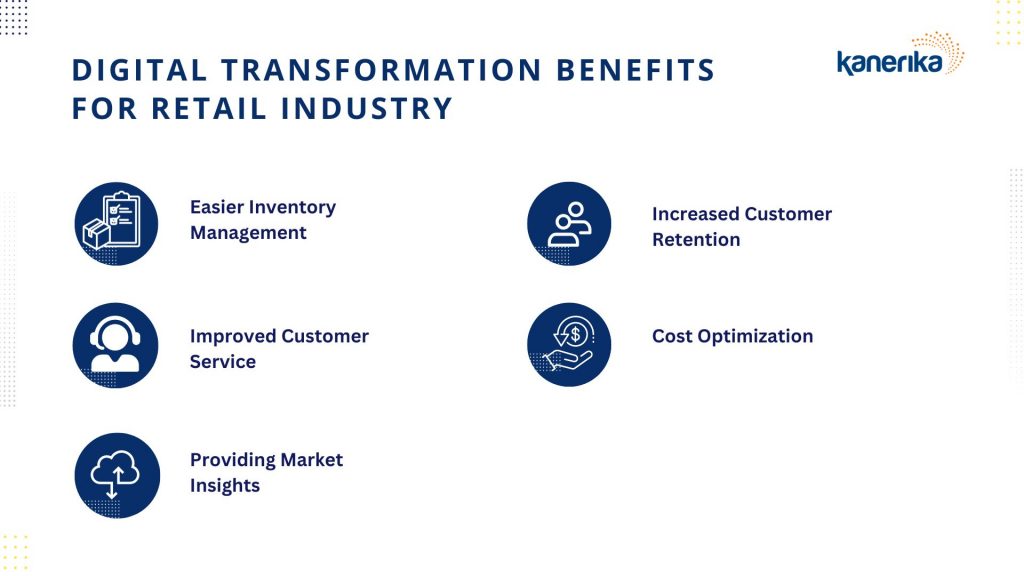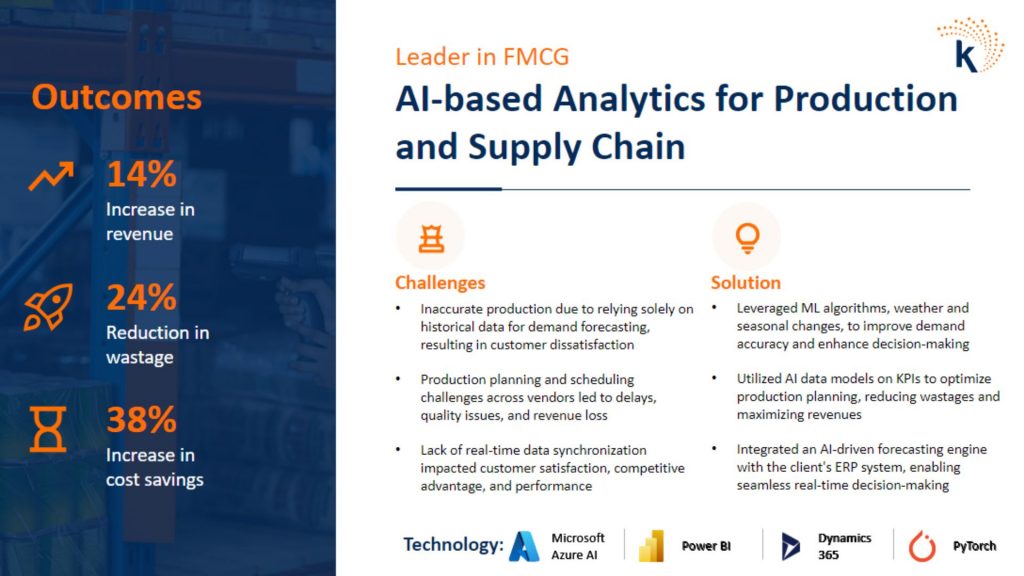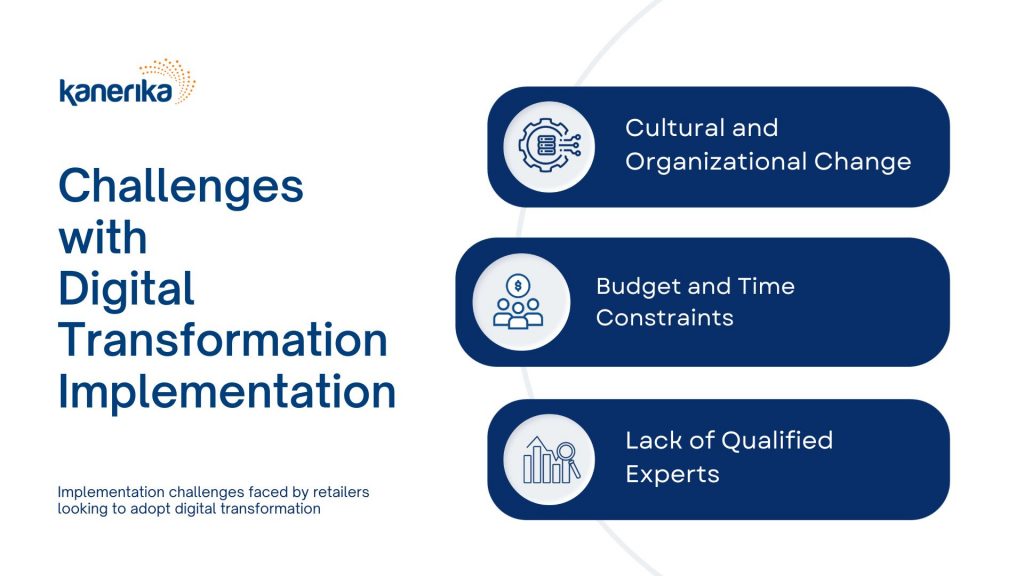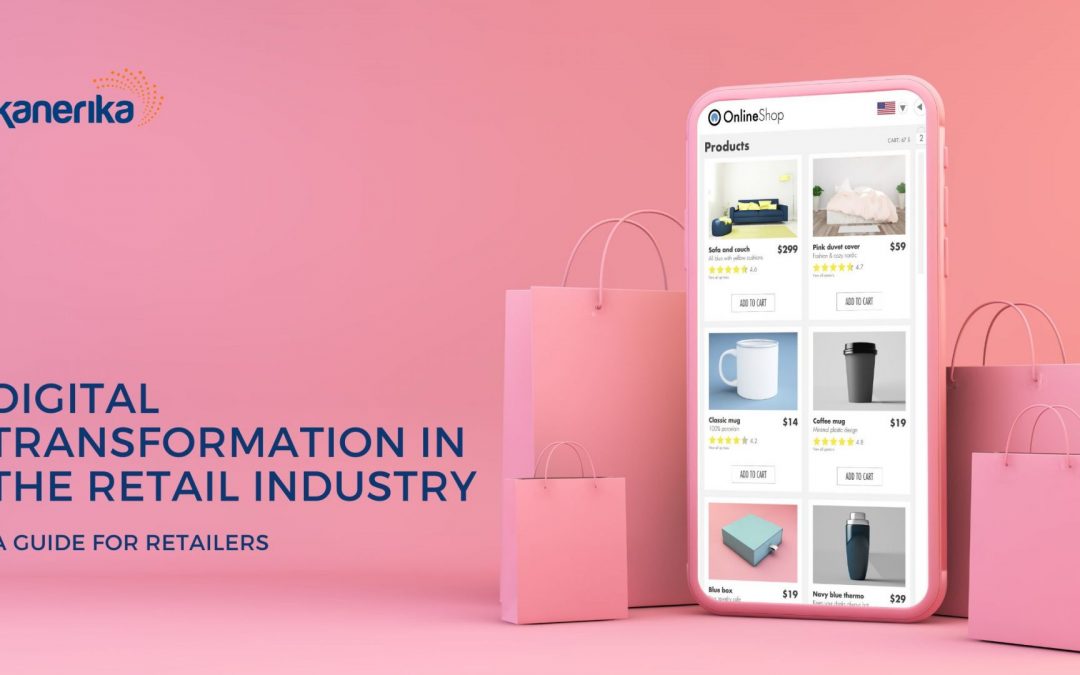Meet Amy, whose childhood memories are laced with the excitement of weekend trips to the local mall. At 11, she and her sister would head for the glittering aisles, their arms soon heavy with the latest trends in retail. Waltzing in and out of dressing rooms, time slipped by unnoticed as they shopped for hours.
Today, at 23, Amy’s shopping spree happens with a few taps on her phone, where personalized selections await her approval. She completes her payment online through a secure portal and gets regular updates on her delivery; all of this is achieved digitally without ever visiting a shop in-person.
This shift epitomizes digital transformation in the retail industry—a revolution that’s redefining the shopping experience through technology. Retailers stand to gain the most out of this shift in consumer spending behaviors.
This transformative digital transformation wave is a strategic evolution that’s not just enhancing the customer experience but also propelling business growth for retailers. With Gartner’s research indicating that over 50% of consumer spending will be online by 2023, with a significant portion via mobile devices, the message is clear: digital transformation in retail is not just inevitable; it’s already here.
In this article, we’ll explore the digital transformation trends in the retail industry, and digital transformation in retail examples. Join us as we navigate through the digital metamorphosis that is reshaping the retail landscape.
Table of Contents
- What is Digital Transformation in the Retail Industry?
- Why Businesses Need Digital Transformation in the Retail Industry
- Benefits of Digital Transformation in the Retail Industry
- Case Studies of Successful Digital Transformation
- Latest Trends in Digital Transformation in the Retail Industry
- Challenges in Implementing Digital Transformation in the Retail Industry
- Kanerika – Your Partner in Digital Transformation in the Retail Industry
- FAQs
What is Digital Transformation in the Retail Industry?
As Gen Z, a demographic born after 1998, comes into an estimated $44 billion in buying power, with 93% of their parents acknowledging their influence on household spending, the retail industry is on the cusp of a significant shift. In a few short years, Gen Z will command 40% of all consumer shopping, driving a surge in digital transformation in the retail industry.
Digital transformation in retail business is about harnessing digital technologies to revolutionize business processes, customer experiences, and organizational structures.
It’s a strategic overhaul aimed at enhancing the shopping journey and boosting retailer profitability.
This transformation encompasses the integration of e-commerce platforms, mobile applications, AI and machine learning, analytics software, and cloud computing services.
For instance, predictive analytics can forecast trends with precision, while augmented reality (AR) lets consumers virtually try products before buying. Such innovations are not just futuristic concepts but are already making a tangible impact.
They are part of why digital transformation in retail banking, retail business, and the retail market is not just a trend but a cornerstone of modern commerce.
Why Businesses Need Digital Transformation in the Retail Industry
Black Friday and Cyber Monday sales have become the bellwethers of the retail industry’s health and consumer spending trends. Consider 2021’s figures: 155 million Americans shopped during this period, spending an average of $430 each. Millennials, particularly, are driving this digital surge, with 93% of this tech-savvy cohort, who spend roughly $419.52 per person, preferring to shop online during these peak times.
The trend is clear: online shopping is king, with a colossal $8.9 billion spent digitally on Black Friday alone. This shift is partly due to the convenience of avoiding crowded stores, with half of the shoppers choosing to browse from the comfort of their homes.
The digital experience is further enhanced by AI, with 47% of consumers open to using chatbots for purchases, a market expected to reach $112 billion by 2023 according to Juniper Research.
The digital transformation in the retail industry is clearly reshaping consumer expectations. With digital transformation in stores, retailers can unlock growth, tapping into the potential of e-commerce which is projected to generate over $300 billion in the fashion sector by 2027 alone. The message is clear: retailers choosing digital transformation in stores are expected to stay relevant and drive revenue forward.
Benefits of Digital Transformation in the Retail Industry

Easier Inventory Management with Technologies like AI and RPA
Efficient inventory management is crucial in retail, where $1.1 trillion—about 7% of the US GDP—is tied up in inventory and related assets. With warehouse space costing an average of $5.08 per square foot and retailers holding $1.43 in inventory for every dollar of sales, the pressure to optimize is immense. In fact, ineffective inventory control is a leading cause of startup failures, prompting 75% of supply chain professionals to seek improvements.
Digital transformation in the retail industry addresses these challenges head-on. AI and robotic process automation (RPA) are streamlining operations, cutting labor costs, and enabling rapid response to customer needs. Real-time tracking with radio-frequency identification (RFID) tags eliminates the need for manual counts, and automated checkout systems expedite the purchasing process, enhancing customer satisfaction.
These digital solutions transform inventory management, allowing retailers to maintain optimal stock levels, manage warehouses efficiently, and avoid stock-outs.
Read More – Key Considerations for a Successful Digital Transformation Strategy
Improved Customer Service with Omnichannel Experience
The rise of mobile commerce is undeniable, with mobile e-commerce revenue on track to hit $728.28 billion by 2025. This surge is largely due to the convenience smartphones and tablets bring to online shopping. Digital transformation in the retail industry is pivotal in harnessing this trend to deliver superior customer service.
Retailers are now crafting an omnichannel experience, enabling customers to seamlessly interact through various platforms such as websites, mobile apps, email, and live chat. Digital transformation in stores equips businesses with tools like chatbots that offer 24/7 customer service, providing immediate, personalized assistance.
Industry Example: Target’s Customer-Centric Mobile App
Take Target’s mobile app as a prime example. As one of the top 10 largest U.S. retailers, Target has developed a free app that deeply integrates customers into the shopping experience.
The app integrates several features that streamline the shopping process, including the organization of shopping lists, the ability to sign up for and redeem coupons, and the functionality to search for and locate items within the store. It also informs customers of in-store sales and offers instant coupons, enhancing the value of every visit.
Beyond these features, the app supports contactless shopping with in-store pickup and home delivery options and allows customers to scan their receipts for cash-back rewards on both in-store and app purchases.
Through such digital enhancements, Target has not only improved its customer service but has also set a new standard for digital transformation in the retail industry.
Providing Market Insights with Data Analytics
Data analytics, empowered by digital transformation in the retail industry, is reshaping how retailers understand consumer behavior to optimize marketing and pricing for peak profitability.
AI-driven predictive analysis enhances this by providing actionable recommendations based on historical consumer data, allowing for more informed decision-making.
Retailers can now dissect customer segments and buying patterns to tailor strategies and trigger personalized promotions. For instance, a retailer might use purchase history to craft a targeted campaign for a health supplement enthusiast, thereby increasing both purchase frequency and customer loyalty.
Additionally, retailers can send personalized product recommendations via email or suggest complementary items on e-commerce platforms, enhancing the shopping experience.
Industry Example: Uber Eats and Express’ AI-Driven User Suggestions
Companies like Uber Eats and fashion retailer Express are already capitalizing on this by recommending additional food items or accessories that complement a customer’s choice. This strategy not only boosts sales but also enriches the customer experience with thoughtful, relevant suggestions, showcasing the value of digital transformation in retail sector.
Increased Customer Retention with Predictive Analytics and Consumer Behavioral Insights
In the dynamic landscape of retail, data analytics, and AI-driven predictive analysis are pivotal for gaining actionable insights into consumer behavior. These insights empower retailers to refine marketing strategies and pricing for optimal profitability. By analyzing customer segments and purchase patterns, retailers can devise personalized promotions, enhancing customer loyalty and purchase frequency.
Consider a fitness enthusiast who regularly buys health supplements. Retailers can use data insights to craft targeted campaigns, encouraging repeat business. Moreover, retailers can utilize purchase tracking to offer customers tailored product recommendations via email or suggestive selling on e-commerce platforms.
For example, Uber Eats uses visual prompts to upsell related food items, increasing order size. Similarly, a fashion retailer like Express might recommend accessories to match a recently purchased dress, personalizing the experience and potentially boosting sales. This is a primary benefit of retailers adopting digital transformation in stores.
Cost Optimization with Cloud Computing
Global spending on digital business transformation is expected to soar to $3.4 trillion by 2026.
This will be driven by digital solutions that automate and refine processes like inventory management and order processing, thereby cutting costs and increasing accuracy. Cloud computing amplifies these benefits by providing scalable solutions that negate the need for costly hardware investments.
A case in point is an e-commerce store that revamped its infrastructure on a cloud platform, carefully selecting services to match its traffic and usage patterns. This strategic approach, coupled with continuous performance monitoring, led to a significant cost reduction, with expenses dropping by over 26% in the first month alone. These benefits are a strong point for businesses to consider digital transformation in retail market.
Case Studies of Successful Digital Transformation
In the digital era, Kanerika has been at the forefront of transforming businesses through innovative technology solutions. Two case studies highlight the remarkable outcomes of Kanerika’s digital transformation efforts.
Firstly, Kanerika addressed the challenges of a global health-tech company struggling with data silos and an outdated UI/UX.

By leveraging Snowflake for data integration and Power BI for intuitive design, Kanerika facilitated a 25% increase in data-driven decisions and a 61% reduction in time to information, significantly enhancing decision-making and user engagement.
Secondly, for an FMCG leader, Kanerika’s implementation of machine learning algorithms and AI data models revolutionized production forecasting and planning.

This strategic integration resulted in a 14% revenue increase and a 38% rise in cost savings, showcasing Kanerika’s ability to drive profitability and efficiency through digital innovation.
These case studies exemplify Kanerika’s expertise in harnessing technology to deliver tangible business results.
Latest Trends in Digital Transformation in the Retail Industry
Incorporating the latest trends in digital transformation into the retail industry is crucial for keeping pace with evolving consumer expectations and market demands. Let’s delve into how these technologies are impacting the retail sector:
Omnichannel
Omnichannel retailing is emerging as a standard for enhancing the customer experience (CX). This approach integrates various customer touchpoints, including online, in-store, and mobile channels, to provide a seamless shopping experience.
A notable example is Decathlon, which has achieved record-breaking growth by integrating apps, systems, and data for an omnichannel experience. Their digital transformation includes a personalized e-commerce app, a cloud-based order management system, cashless checkout via mobile scan and pay, and RFID tags for inventory management. This integration allows customers to enjoy a seamless journey across digital and physical stores, positively impacting business growth.
Blockchain Technology
Blockchain technology has significantly transformed the retail industry, particularly in supply chain management. It brings a high degree of transparency and traceability, documenting every transaction in a decentralized ledger.
Retail giants like Walmart and IBM have initiated blockchain applications to track product origins and ensure quality, demonstrating the technology’s potential for transparency and efficiency in the supply chain. Additionally, smart contracts automate payments and deliveries, streamlining supply chain management and reducing errors.
Augmented Reality (AR)
Augmented reality (AR) is revolutionizing retail by enhancing the customer-brand relationship. As digitally native shoppers increasingly dominate the marketplace, 66% of consumers express interest in using AR for purchasing decisions.
By 2025, almost all smartphone users are expected to be frequent AR users. Retailers are leveraging AR to create immersive shopping experiences, such as Starbucks’ AR experience, which educates customers about their coffee’s journey.
AR significantly impacts in-store and online conversion rates, with merchants who add 3D content to their stores seeing a 94% conversion lift on average.
Furthermore, AR facilitates contactless transactions and serves as a powerful marketing tool, as evidenced by Ulta Beauty’s shoppable AR filters on Snapchat, enhancing brand awareness and customer engagement
Challenges in Implementing Digital Transformation in the Retail Industry

Implementing digital transformation in the retail industry is not without its challenges, as organizations navigate through a landscape of evolving technologies and market dynamics.
Cultural and Organizational Change
One of the primary challenges is managing cultural and organizational change. Digital transformation often faces resistance as it disrupts traditional methods and roles within a company.
The key lies in effective leadership and communication, ensuring that the transformation is perceived not as a crisis-driven change but as a proactive step towards future-proofing the business.
Budget Constraints
Budget constraints pose another significant hurdle. Retailers embarking on the path of digital modernization need to brace for ongoing expenses. Since digital transformation is a continuous process rather than a one-time investment, it can strain financial resources and necessitate careful budgeting and financial planning.
Lack of Qualified Experts
Lastly, the shortage of qualified experts is a considerable barrier. Trends like remote work have made the talent shortage worse, especially in IT roles crucial for digital transformation like cloud and edge computing, automation, and continuous delivery. This shortage hampers the adoption of new technologies as organizations struggle to find professionals with the necessary skill sets to lead and implement these transformative initiatives.
These challenges require a strategic approach, combining strong leadership, resource allocation, and talent acquisition to successfully implement digital transformation in the retail sector. Working with a trusted consulting company like Kanerika can help you achieve your digital transformation goals.
Kanerika – Your Partner in Digital Transformation in the Retail Industry
With 20+ years of proven experience in digital transformation and consulting through technologies such as data analytics, AI, and RPA, Kanerika offers enterprise solutions that transform business operations.
Kanerika’s team of 100+ skilled professionals is well-versed in all the leading digital transformation trends in the retail industry and has integrated solutions across multiple industries. This ensures businesses harness digital transformation to the retail industry’s full potential.
Partner with Kanerika and leverage cutting-edge digital solutions for your business.
FAQs
1. What is the digital transformation in retail industry?
2. How does digital transformation affect retail?
3. What are the benefits of digital transformation in retail?
4. What are the three stages of digital retailing strategy?
- Establishing an online presence and integrating digital tools.
- Enhancing customer engagement through personalized experiences and omnichannel strategies.
- Leveraging data analytics and AI for insights-driven decision-making and continuous innovation.















